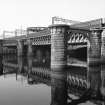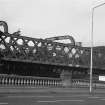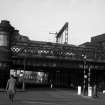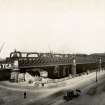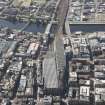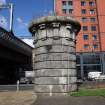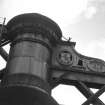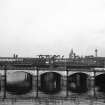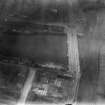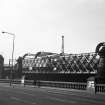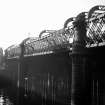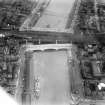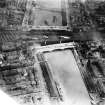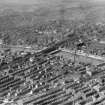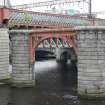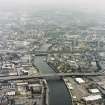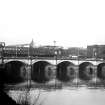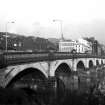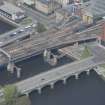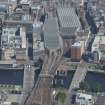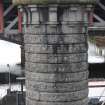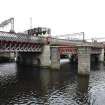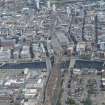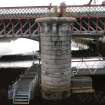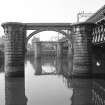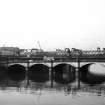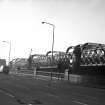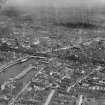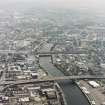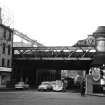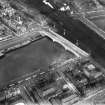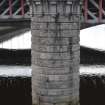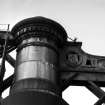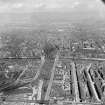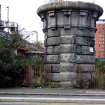Glasgow, Central Station, Old Approach Viaduct
Graffiti (21st Century), Railway Bridge (19th Century), Railway Bridge (20th Century)
Site Name Glasgow, Central Station, Old Approach Viaduct
Classification Graffiti (21st Century), Railway Bridge (19th Century), Railway Bridge (20th Century)
Alternative Name(s) River Clyde; Caledonian Railway Bridge; Glasgow, Central Station, Old Railway Bridge
Canmore ID 91763
Site Number NS56SE 140
NGR NS 58730 64795
Datum OSGB36 - NGR
Permalink http://canmore.org.uk/site/91763
- Council Glasgow, City Of
- Parish Glasgow (City Of Glasgow)
- Former Region Strathclyde
- Former District City Of Glasgow
- Former County Lanarkshire
NS56SE 140.00 58730 64795
Location formerly cited as NS 5870 6471 to 5873 6486.
NS56SE 140.01 5871 6488 to 5867 6473 (new approach viaduct).
For adjacent (to N) and associated Central Station, see NS56SE 77.
(Central Station Bridges). The first bridge was built 1876-8 for the Caledonian Railway, being designed by Blyth and Cunningham, engineers, and built by Sir William Arrol and Company. It was about 700ft (213.4m) long. The approach spans, over Clyde Place [to the S] and the Broomielaw [to the N], were of plate and lattice girder construction, respectively 60ft [18.3m] andf 90ft [27.4m] long, while the main spans were 164ft [50m], 184ft [56.1m] and 152ft [46.3m] long. These latter were formed of wrought iron lattice girders with their top edges linked by light arched lattice girders. The girders were carried on twin masonry piers linked by cast-iron arches. At each end of the bridge were cast-iron plaques with the Caledonian lion rampant encircled by a garter, with the date 1878.
This bridge was demolished in 1966-7, only the granite piers and cast iron arches remaining.
J R Hume 1974.
(Caledonian Railway Bridges). Of the first bridge, built in 1876-8 (engineer B H Blyth of Blyth and Cunningham of Edinburgh; contractor William Arrol and Co), contemporary with the first part of Central Station (NS56SE 77), only the piers remain just upstream [to the E] of the second and current bridge (NS56SE 140.01), the tracks and girders having been removed in 1966-7. For each pier, two cast iron cylinders, 4.5m (15ft) diameter in the river and 4m (13ft)on the banks, were sunk to bedrock, filled with concrete and extended above the river-bed with masonry, the outside stones being of Dalbeattie granite. The two granite shafts of each pier rise high out of the water, and are still linked by arched cast iron frames placed there, by the engineer's admission, purely for ornament.
E Williamson, A Riches and M Higgs 1990.
The earlier (E) of these two bridges was opened on 1 August 1879 to allow Caledonian Rly access to the (new) Central Station (NS56NE 77). As part of the (1899-1905) expansion of Central Station a second bridge (of comparable appearance) was added on the W. The new bridge was brought into use in March 1905. At the same time, the old bridge was re-floored to bring it up to the height of the new. Re-signalling in 1960 and 1966 rendered it redundant, and it was demolished; the new bridge remains in use.
M Smith 1994.
Although commonly termed a viaduct, this structure is more properly to be considered a bridge. It formerly carried the original approach tracks of the Caledonian Rly main line across the River Clyde into Central Station (NS56NE 77), immediately to the N. It thus formed the most northerly portion of the West Coast Main Line (from London, Euston). Its construction was a major event in the railway history of Glasgow, allowing the eventual closure of the former terminus (NS56SE 467) at Bridge Street Station (to the S of the river).
The location assigned to this record defines the centre of the former span. The high approaches on each side render the extent of the structure unclear, but the available map evidence suggests that it extends from NS c. 58745 64905 to NS c. 59695 64695. The river here forms the boundary between the parishes of Glasgoiw (to the N) and Govan (to the S).
The 1967 edition of the OS 1:1250 map notes what are evidently the remaining standing pillars of this structure as follows:
Pillar [NAT] (at NS 58747 64877: on land, on the S side of Clyde Street)
Pillar [NAT] (at NS 58735 64827: in the river, towards the N side)
Pillars [NAT] (at NS 58706 64772 and NS 58722 64768: in the river, towards the S side)
Pillar [NAT] (at NS 58709 64710: on land, on the N side of Clyde Place).
Information from RCAHMS (RJCM), 19 December 2005.
Field Visit (14 May 2015)
All that remains of this railway bridge are four granite-clad piers. On the E faces of the two easternmost piers are inscriptions by the artist Ian Hamilton Finlay. Written in both English and Ancient Greek, the quote from Plato’s Republic reads:
‘All Greatness Stands Firm in the Storm’ and the Greek section which translates loosely as ‘All great things are perilous, and it is true, as the proverb says, that beautiful things are hard [to attain]’.
Visited by RCAHMS (AGCH, GLB) 14 May 2015.
Field Visit (28 September 2017)
The freestanding southernmost pier (NS 58709 64715) on the east side of the remains of this bridge has been spray painted with graffiti on its south side.
Visited by HES Survey and Recording (JRS, AMcC) 28 September 2017.









































